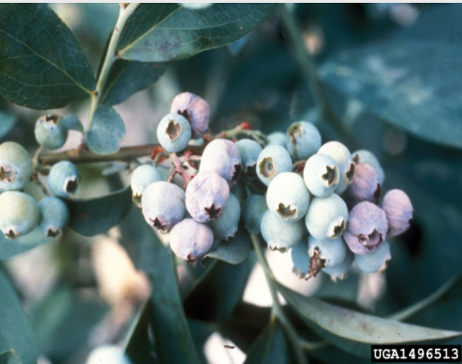Mummy Berry of Blueberries
go.ncsu.edu/readext?829021
en Español / em Português
El inglés es el idioma de control de esta página. En la medida en que haya algún conflicto entre la traducción al inglés y la traducción, el inglés prevalece.
Al hacer clic en el enlace de traducción se activa un servicio de traducción gratuito para convertir la página al español. Al igual que con cualquier traducción por Internet, la conversión no es sensible al contexto y puede que no traduzca el texto en su significado original. NC State Extension no garantiza la exactitud del texto traducido. Por favor, tenga en cuenta que algunas aplicaciones y/o servicios pueden no funcionar como se espera cuando se traducen.
Português
Inglês é o idioma de controle desta página. Na medida que haja algum conflito entre o texto original em Inglês e a tradução, o Inglês prevalece.
Ao clicar no link de tradução, um serviço gratuito de tradução será ativado para converter a página para o Português. Como em qualquer tradução pela internet, a conversão não é sensivel ao contexto e pode não ocorrer a tradução para o significado orginal. O serviço de Extensão da Carolina do Norte (NC State Extension) não garante a exatidão do texto traduzido. Por favor, observe que algumas funções ou serviços podem não funcionar como esperado após a tradução.
English
English is the controlling language of this page. To the extent there is any conflict between the English text and the translation, English controls.
Clicking on the translation link activates a free translation service to convert the page to Spanish. As with any Internet translation, the conversion is not context-sensitive and may not translate the text to its original meaning. NC State Extension does not guarantee the accuracy of the translated text. Please note that some applications and/or services may not function as expected when translated.
Collapse ▲Mummies are not just for Halloween. Well actually Mummy Berries. Mummy berry disease is pretty scary. In 2019 the dollar value of cultivated blueberries in our state was over $908,677,000. Mummy berry disease, caused by the fungal pathogen Monilinia vaccinii-corymbosi, is one of the most economically important diseases of blueberries. If left untreated, crop damage as high as 50% can occur during normal growing seasons. That’s a significant financial blow to this popular crop. Our home gardens are not immune to it either.
While blueberries are one of the most popular backyard fruits because they are relatively low maintenance compared to other fruit species, mummy berry disease is likely the most common disease of blueberries in North America. Its severity varies greatly from year to year depending on weather conditions.
As the name implies, the ripening berry develops a dry, shriveled appearance, then drops from the bush as a result of this disease infection. The berries are a pinkish rather than blue color. This fungus can overwinter inside the fallen infected berry, remaining viable for several years. Some blueberry varieties are more susceptible than others. A cool, wet spring combined with late freezes sets the stage for this  fungus to get established. When the spores come out of the infected berries on the ground the wind spreads them to nearby plants where they will infect beginning shoots and leaves. This causes sudden wilting to the plant – from the leaves and buds to the stems and flower clusters. As the infection gains momentum brown necrosis sets in followed by powdery masses of sporulation. From there the secondary spore growth is carried to open flowers along with pollen, often spread by pollinators visiting from one bloom to the next so that the infection makes it into the developing berry through the fruit ovaries.
fungus to get established. When the spores come out of the infected berries on the ground the wind spreads them to nearby plants where they will infect beginning shoots and leaves. This causes sudden wilting to the plant – from the leaves and buds to the stems and flower clusters. As the infection gains momentum brown necrosis sets in followed by powdery masses of sporulation. From there the secondary spore growth is carried to open flowers along with pollen, often spread by pollinators visiting from one bloom to the next so that the infection makes it into the developing berry through the fruit ovaries.
Most of the time we don’t notice the problem until it’s time to harvest that season’s berry crop but it’s too late. If the infection has hit the berry plantings, expect it to erupt again the following year unless action is taken.
A few well timed applications of the appropriate fungicide early in the growing season soon after bud break can make a real difference if it’s combined with diligent sanitation practices in the fall. Burying mummies helps to prevent primary infections. Rake mummies into the row centers between the plants and bury them at least 1” deep. Use caution; excessive amounts of dirt mounded on top of blueberry roots and stems can result in injury or plant death.
Scout your plants and get a plan in place for next spring before blooms begin. If mummy berry disease is present, appropriate fungicides are very important in pre-bloom sprays (for cultivars or seasons in which leaf bud break occurs before flower bud break). Start spraying when green tip occurs on the leaf buds or 1-5% open bloom occurs on the flower buds, whichever comes first. Continue sprays until all blooms have fallen. To find out more contact Minda Daughtry, Horticulture Agent for North Carolina Cooperative Extension in Lee County.




